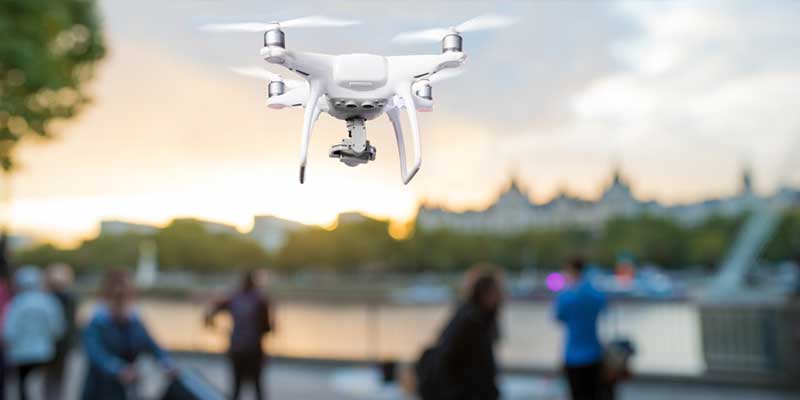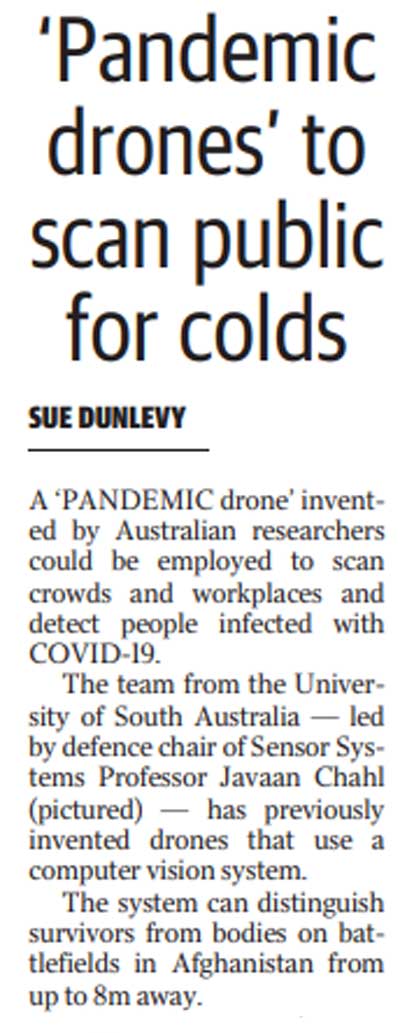UniSA working on ‘pandemic drone’ to detect coronavirus
By Candy Gibson
 TECHNOLOGY AND ENGINEERING A hovering drone fitted with a computer vision system will be able to detect people with COVID-19.
TECHNOLOGY AND ENGINEERING A hovering drone fitted with a computer vision system will be able to detect people with COVID-19.A ‘pandemic drone’ to remotely monitor and detect people with infectious respiratory conditions is being developed by UniSA in partnership with a Canadian company.
 This research has made headlines around Australia and the world, including Sydney's Daily Telegraph
This research has made headlines around Australia and the world, including Sydney's Daily TelegraphThe UniSA team led by Defence Chair of Sensor Systems Professor Javaan Chahl, who holds a joint appointment with Defence Science and Technology (DST), will work with Draganfly Inc, a North American drone technology company, to immediately start integrating commercial, medical and government customers.The drone will be fitted with a specialised sensor and computer vision system that can monitor temperature, heart and respiratory rates, as well as detect people sneezing and coughing in crowds, offices, airports, cruise ships, aged care homes and other places where groups of people may work or congregate.
Prof Chahl, working alongside Dr Ali Al-Naji and Asanka Perera, achieved global recognition in 2017 when they demonstrated image-processing algorithms that could extract a human’s heart rate from drone video.
Since then they have demonstrated that heart rate and breathing rate can be measured with high accuracy within 5-10 metres of people, using drones and at distances of up to 50 metres with fixed cameras. They have also developed algorithms that can interpret human actions such as sneezing and coughing.
He says the technology could be a viable screening tool for the COVID-19 pandemic.
“It might not detect all cases, but it could be a reliable tool to detect the presence of the disease in a place or in a group of people.”
Prof Chahl says the technology was originally envisaged for war zones and natural disasters as well as remotely monitoring heart rates of premature babies in incubators.
“Now, shockingly, we see a need for its use immediately, to help save lives in the biggest health catastrophe the world has experienced in the past 100 years.”
Draganfly CEO Cameron Chell says his company will use its sensor, software and engineering expertise to work with UniSA to integrate and deploy for government, medical and commercial customers.
“We are honoured to work on such an important project given the current pandemic facing the world with Covid-19. Health and respiratory monitoring will be vital not only for detection but also to understand health trends,” Chell says.
Other Stories
- $10m fund established to support UniSA’s most vulnerable students amid COVID-19 fallout
- Helping each other through ‘normal’ fear and panic
- Help at hand for staff making the switch to online teaching
- Six strategies to juggle work and young kids at home
- Working from home? Count your virtual blessings
- From the Vice Chancellor
- Achievements and Announcements
- How to set up healthy habits during social distancing
- Celebrating Denise: innovator, trailblazer and leader
- Pets give their humans a strong rationale for life
- Special funds from UniSA to support community and wildlife recovery on Kangaroo Island
- UniSA working on ‘pandemic drone’ to detect coronavirus
- MOD. and Hawke Centre expand online offerings
- “What do stars do? They shine” … UniSA honours author and creative dynamo, Neil Gaiman
- IN PICTURES: International Women's Day and National Apology breakfasts




